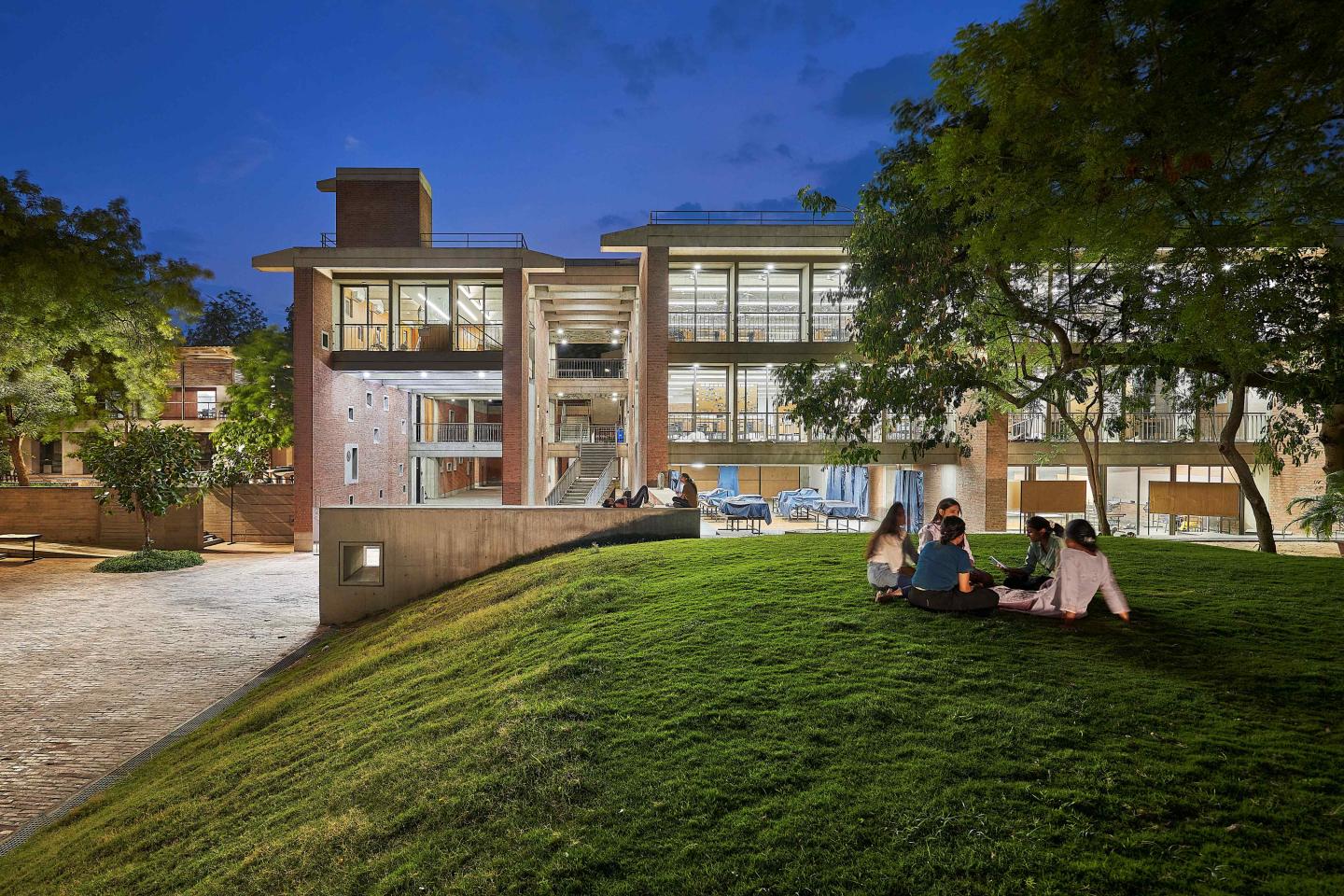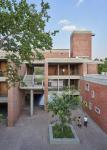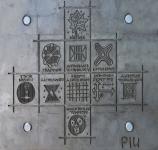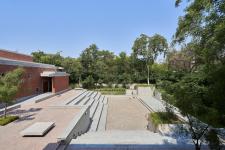The Symbolic Endeavour:
Located adjacent to the School of Architecture, the new block is designed to reinforce the cultural continuity of the existing campuses architectural language and consists of rectangular juxtaposed volumes containing three components:
· The Foundation Center
· The Lecture Hall
· The Kund
The new block fosters a sense of physical and visual connectivity with the iconic grass hillock and School of Architecture next door. The Foundation Centre and the Lecture Hall are perched in an L-shaped layout on the site and envelope the Kund that ties the two together by harbouring a new activity hub for the campus.
The Foundation Center:
The Foundation Center is a double-storey structure that continues the play of open-plan layouts of the existing campus. Designed to house six studios and six classrooms that accommodate around 300 students, the design follows the celebrated material palette of exposed bricks and concrete, synonymous with the identity of the campus and the architectural language of modern Ahmedabad. Two staircases at either end of the structure lead to the Foundation Studios upstairs. They are set deep inside the volumes to tackle the harsh Ahmedabad heat and open up to balconies that frame the facade of the building.
The spatial functionality of the studios adopts a similar open layout borrowed from its sister building, the School of Architecture by B. V. Doshi. Reflecting the traditional architectural heritage of the city, exposed concrete jack arches are incorporated and flanked by skylights on either side to improve the natural lighting. Frosted glass flooring is used in the passageways to increase light filtration through the volumes.
The Balwantrai N. Brahmbhatt Lecture Hall:
The Lecture Hall is a single-storey structure with a capacity to accommodate 450 students. Its warm interiors are further heightened by its wooden furnishings which were conceptualised and designed by Ismet Khambatta’s, 'The Design Workshop'. The use of coloured glass for its boxy openings creates a colourful chiaroscuro effect in the backdrop.
The Kund: a hub for activities
The northwest corner of the site was the lowest point of the CEPT campus because of which it was plagued by stagnant water accumulation during heavy monsoon. This led to the area being neglected and often inaccessible. To make this part of the campus habitable CCBA Designs introduced a groundwater recharged pit which allowed the water to drain, making the design intervention adapt to the seasonal changes of the city. This ingenious design solution took the form of a traditional water harvesting kund which doubled as an open-air amphitheatre and performance center for students and their social activities. In doing so, the Kund becomes a living entity, moulding itself to suit the needs of the young users while quietly transforming into a beautiful water feature during monsoons, mimicking traditional Amdavadi step wells.
The Murals: an artistic expression
For Prof. Benninger, murals play a very important role. The new academic block features a large number of murals cast in situ on its concrete ceilings. These act as personalised notes given by the architect himself to the young students, to foster an ever-growing curiosity to learn and observe from one’s surroundings. Some of them include Le Corbusier’s famous 'Modulor Man', and Benninger’s own 'Principles of Intelligent Urbanism'. The Modulor Man is a human figure synthesising a universal system of proportions, while the Principles of Intelligent Urbanism is a theory composed of a set of ten axioms intended to guide the formulation of city plans and urban designs.
The architectural vocabulary of the new block is dictated by the context of modern architectural heritage in which the structure has been built. Thus, instead of diverging from the material palette, the project uses standard materials in innovative ways. The building borrows materiality, scope, and expression from the site and builds upon the environs to create a masterpiece that would not only blend with the fabric but complement the aesthetic and legacy of the campus.
In movement with sustainability:
The design becomes sustainable through a series of conscious decisions taken at various stages of the design process. Put simply, sensitive design is sustainable design. Thus, it is built into the design process in all aspects, from conceptualization to planning and design. It is not an additive but an integral part of the process. The New Academic Block follows the same by adopting a design language that is sensitive to the context and the climate. Careful material selection, sizing and detailing helped to minimize residual wastage. We engaged with Contractors and the PMC to help optimize the construction processes. Moreover, a sound EHS policy (Environment, Health and Safety Policy) is one of the prerequisites that a Contractor has to submit to qualify for work on any of our projects. The implementation of design interventions such as the Kund not only preserved a vital resource like water but also helped foster student activities. This dual role of the design added beauty to the built landscape of CEPT University.
2019
2020
Location: Ahmedabad, Gujarat, India
Client: CEPT University.
Built Up Area: 5,000 sq.m
Site Area: 17 Acres
Completion date: 2022
Lead architect: Professor Christopher Charles Benninger, Founder and Principal Architect.
Mentors: Ramprasad Akkisetti (Managing Director), Rahul Sathe (Director) and Daraius Choksi (Studio Director)
Design Team: Ar. Shivaji Karekar and Ar. Neeraj Nijampurkar
Landscape Design: Ravi & Varsha Gavandi
Interior Design: CCBA Designs & Ismet Khambatta - TDW Furniture. Pvt. Ltd
Prime Contractor: PSP Projects Limited
Structural Design: N. K. Shah Consulting Engineers LLP.
Construction Management: CEPT University
Utility Design: Prachtvoll Engineers pvt. Ltd
MEP: Prachtvoll Engineers pvt. Ltd
Acoustics: Sonics
Text Credits: Ar. Venessa Thomas
Photograph Credits: Ashish Bhonde and Ramprasad Akkisetti
Ar. Shivaji Karekar and Ar. Neeraj Nijampurkar











